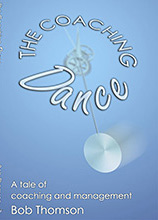Coaching for Business
A Q&A with Bob Thomson, Learning and Development Centre
Published October 2012
In football, the job of the coach is to find the best talent and bring out their potential on the field. Coaching for business is equally looking to bring out the best in employees and their management teams. In this Q&A, Bob Thomson discusses his experience and knowledge of this management tool.
 You’ve worked for a number of blue-chip companies, including ICI and National Grid Transco, and have seen a number of different management styles come in and out of fashion during your career so far. What tangible benefits and improved outcomes does coaching offer that previous management styles have not achieved?
You’ve worked for a number of blue-chip companies, including ICI and National Grid Transco, and have seen a number of different management styles come in and out of fashion during your career so far. What tangible benefits and improved outcomes does coaching offer that previous management styles have not achieved?
A coaching style of management is far more likely to tap into the ideas, knowledge and creativity of people than a more traditional command and control style. If you encourage people to bring forward their own ideas, they feel more motivated, their capability grows, and over time far more of their potential is released.
You have two books out on the subject of non-directive coaching. What is it and do you feel it is right for all sizes of business, all managers and all types of employees?
A non-directive coach uses their ability to listen and to ask open questions to help the other person clarify what matters to them and to work out for themself what they’re going to do. You might sum this up in an equation: ‘Awareness + Responsibility = Performance’. Through conversation the coach helps the other person become more aware of what they need to do and encourages them to take responsibility. This enables them to perform, whatever performance means in their context. It might be managing a sales team, finishing a PhD or hitting a golf ball.
This means that non-directive coaching can be used in all sorts of contexts and businesses. But a key point is that the individual must be willing to be coached. It’s difficult – perhaps impossible – to coach someone who doesn’t want to take responsibility or who isn’t willing to engage in the conversation.
Moreover, there is definitely a place for direction too. You might, for instance, be directive with an employee who is new and inexperienced, telling them what you want them to do. In my book The Coaching Dance, a novice manager learns how to move gracefully between telling (“I must have this report by Friday”) and asking (“What do you need to do to finish the report by Friday?”)
What makes a good coach? Are the skills different to being a good mentor?
 The skills of coaching and mentoring are similar. The skills needed to have useful conversations are the ability to listen in order to understand: to ask open questions that help the other person think and to play back accurately what they have said or maybe communicated non-verbally. At a deeper level, the coach or mentor has to be able to create a relationship of rapport and trust with each of their clients.
The skills of coaching and mentoring are similar. The skills needed to have useful conversations are the ability to listen in order to understand: to ask open questions that help the other person think and to play back accurately what they have said or maybe communicated non-verbally. At a deeper level, the coach or mentor has to be able to create a relationship of rapport and trust with each of their clients.
For me, the difference between coaching and mentoring is that the mentor has some relevant experience and expertise which they use wisely and selectively to advise or guide the other person in their personal development.
In your book you quote someone as capturing the difference between mentoring and coaching through them saying “I couldn’t mentor Barack Obama but I could coach him.” Is there anyone that you would like to coach?
To answer this, I need to be clear why I want to coach that person. To coach non-directively you must be on the other person’s agenda, not yours. A question that often comes up on coaching skills programmes is “How do I coach my boss?” Invariably, a little probing reveals that the person wants to manipulate their boss to do what that individual wants. This is influencing, which is a really useful skill, but it isn’t coaching.
My big interest outside work is football – I play five-a-side in Stratford on Saturday mornings. If I could choose someone to coach, I’d like to work with a young Premier League football manager. Someone like Brendan Rodgers who has just taken over at Liverpool would be great. I’d be fascinated to help him think through what he was trying to achieve with the club and how to do this. And I might even get some complimentary tickets to go to a match at Anfield with my daughter, Eleanor, who is a big Liverpool fan.
 Modern working styles are more flexible and employees are not always in situ for many businesses, whether they’re an SME or large corporation. How does this style of coaching work for businesses that operate like this?
Modern working styles are more flexible and employees are not always in situ for many businesses, whether they’re an SME or large corporation. How does this style of coaching work for businesses that operate like this?
There’s a saying that you can tell how well you’re managing people by what they do when you’re not around. I think a coaching style of management will be far more effective than a command and control approach when people are working remotely.
There’s a growing trend within coaching for conversations to take place over the phone or via Skype. For example, I work with one coaching supervision client essentially by telephone. At Warwick, we’ve recently launched a Coaching through Reflective Writing process in which the contact between coach and client is essentially by writing. In this way of working the coach and client could literally be on opposite sides of the world.
 Bob Thomson is a Learning and Development Adviser at the University of Warwick. He runs the Warwick Leadership Programme and delivers workshops on a variety of management development and personal effectiveness themes. A key feature of his role is the coaching of staff at the University. He is the author of four books: Growing People: learning and developing from day to day experience, Don’t Just Do Something, Sit There: an introduction to non-directive coaching (also available in Chinese under the title Modern Midwifery: the art of coaching), With No Attachment to the Answer – Non-directive coaching: assumptions, approaches and applications, The Coaching Dance – A tale of coaching and management.
Bob Thomson is a Learning and Development Adviser at the University of Warwick. He runs the Warwick Leadership Programme and delivers workshops on a variety of management development and personal effectiveness themes. A key feature of his role is the coaching of staff at the University. He is the author of four books: Growing People: learning and developing from day to day experience, Don’t Just Do Something, Sit There: an introduction to non-directive coaching (also available in Chinese under the title Modern Midwifery: the art of coaching), With No Attachment to the Answer – Non-directive coaching: assumptions, approaches and applications, The Coaching Dance – A tale of coaching and management.
